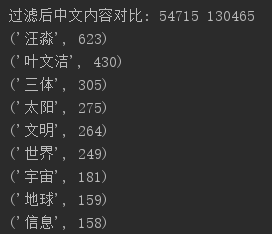作业来源:https://edu.cnblogs.com/campus/gzcc/GZCC-16SE1/homework/2822
1. 下载一长篇中文小说。

2. 从文件读取待分析文本。
1 txt = open(r'G:aa三体.txt', 'r', encoding='utf8').read() # 打开三体小说文件 2 jieba.load_userdict(r'G:aa hree.txt') # 读取三体小说词库 3 4 Filess= open(r'G:aastops_chinese.txt', 'r', encoding='utf8') # 打开中文停用词表 5 stops = Filess.read().split(' ') # 以回车键作为标识符把停用词表放到stops列表中
3. 安装并使用jieba进行中文分词。

4. 更新词库,加入所分析对象的专业词汇。
- 首先下载你要搜索的txt文本
- 进入词库下载专业词库,参考词库下载地址:https://pinyin.sogou.com/dict/

1 # -*- coding: utf-8 -*- 2 import struct 3 import os 4 5 # 拼音表偏移, 6 startPy = 0x1540; 7 8 # 汉语词组表偏移 9 startChinese = 0x2628; 10 11 # 全局拼音表 12 GPy_Table = {} 13 14 # 解析结果 15 # 元组(词频,拼音,中文词组)的列表 16 17 18 # 原始字节码转为字符串 19 def byte2str(data): 20 pos = 0 21 str = '' 22 while pos < len(data): 23 c = chr(struct.unpack('H', bytes([data[pos], data[pos + 1]]))[0]) 24 if c != chr(0): 25 str += c 26 pos += 2 27 return str 28 29 # 获取拼音表 30 def getPyTable(data): 31 data = data[4:] 32 pos = 0 33 while pos < len(data): 34 index = struct.unpack('H', bytes([data[pos],data[pos + 1]]))[0] 35 pos += 2 36 lenPy = struct.unpack('H', bytes([data[pos], data[pos + 1]]))[0] 37 pos += 2 38 py = byte2str(data[pos:pos + lenPy]) 39 40 GPy_Table[index] = py 41 pos += lenPy 42 43 # 获取一个词组的拼音 44 def getWordPy(data): 45 pos = 0 46 ret = '' 47 while pos < len(data): 48 index = struct.unpack('H', bytes([data[pos], data[pos + 1]]))[0] 49 ret += GPy_Table[index] 50 pos += 2 51 return ret 52 53 # 读取中文表 54 def getChinese(data): 55 GTable = [] 56 pos = 0 57 while pos < len(data): 58 # 同音词数量 59 same = struct.unpack('H', bytes([data[pos], data[pos + 1]]))[0] 60 61 # 拼音索引表长度 62 pos += 2 63 py_table_len = struct.unpack('H', bytes([data[pos], data[pos + 1]]))[0] 64 65 # 拼音索引表 66 pos += 2 67 py = getWordPy(data[pos: pos + py_table_len]) 68 69 # 中文词组 70 pos += py_table_len 71 for i in range(same): 72 # 中文词组长度 73 c_len = struct.unpack('H', bytes([data[pos], data[pos + 1]]))[0] 74 # 中文词组 75 pos += 2 76 word = byte2str(data[pos: pos + c_len]) 77 # 扩展数据长度 78 pos += c_len 79 ext_len = struct.unpack('H', bytes([data[pos], data[pos + 1]]))[0] 80 # 词频 81 pos += 2 82 count = struct.unpack('H', bytes([data[pos], data[pos + 1]]))[0] 83 84 # 保存 85 GTable.append((count, py, word)) 86 87 # 到下个词的偏移位置 88 pos += ext_len 89 return GTable 90 91 92 def scel2txt(file_name): 93 print('-' * 60) 94 with open(file_name, 'rb') as f: 95 data = f.read() 96 97 print("词库名:", byte2str(data[0x130:0x338])) # .encode('GB18030') 98 print("词库类型:", byte2str(data[0x338:0x540])) 99 print("描述信息:", byte2str(data[0x540:0xd40])) 100 print("词库示例:", byte2str(data[0xd40:startPy])) 101 102 getPyTable(data[startPy:startChinese]) 103 getChinese(data[startChinese:]) 104 return getChinese(data[startChinese:]) 105 106 if __name__ == '__main__': 107 # scel所在文件夹路径 108 in_path = r"C:UsersAdministratorDownloads" #修改为你的词库文件存放文件夹 109 # 输出词典所在文件夹路径 110 out_path = r"C:UsersAdministratorDownloads ext" # 转换之后文件存放文件夹 111 fin = [fname for fname in os.listdir(in_path) if fname[-5:] == ".scel"] 112 for f in fin: 113 try: 114 for word in scel2txt(os.path.join(in_path, f)): 115 file_path=(os.path.join(out_path, str(f).split('.')[0] + '.txt')) 116 # 保存结果 117 with open(file_path,'a+',encoding='utf-8')as file: 118 file.write(word[2] + ' ') 119 os.remove(os.path.join(in_path, f)) 120 except Exception as e: 121 print(e) 122 pass
5. 生成词频统计

1 # 统计词频次数 2 for word in tokens: 3 if len(word) == 1: 4 continue 5 else: 6 wcdict[word] = wcdict.get(word, 0) + 1
6. 排序

1 # 词频排序 2 wcls = list(wcdict.items()) 3 wcls.sort(key=lambda x: x[1], reverse=True)
7. 排除语法型词汇,代词、冠词、连词等停用词。

1 Filess= open(r'G:aastops_chinese.txt', 'r', encoding='utf8') # 打开中文停用词表 2 stops = Filess.read().split(' ') # 以回车键作为标识符把停用词表放到stops列表中 3 4 tokens=[token for token in wordsls if token not in stops] 5 print("过滤后中文内容对比:",len(tokens), len(wordsls))

8. 输出词频最大TOP20,把结果存放到文件里

1 # 打印前25词频最高的中文 2 for i in range(25): 3 print(wcls[i]) 4 5 # 存储过滤后的文本 6 pd.DataFrame(wcls).to_csv('three.csv', encoding='utf-8') 7 8 # 读取csv词云 9 txt = open('three.csv', 'r', encoding='utf-8').read()

9. 生成词云。

1 # 读取csv词云 2 txt = open('three.csv', 'r', encoding='utf-8').read() 3 4 # 用空格键隔开文本并把它弄进列表中 5 cut_text = "".join(jieba.lcut(txt)) 6 mywc = WordCloud().generate(cut_text) 7 8 plt.imshow(mywc) 9 plt.axis("off") 10 plt.show()
默认形状:

修改背景:


